How to make a water supply in the country: choose pipes, a diagram, a method of installation
The requirements for water supply in the country house are not lower than in city apartments, but higher: it is necessary to ensure supply not only to taps and household appliances, but also for irrigation. Therefore, the pump performance must be high, and the debit of the well or well must be good and stable. One more problem has to be solved: electricity is often cut off in rural areas, therefore it is desirable to have a supply of water or a backup method of its "extraction". For the owners of wells, everything is simple: you can get it with a bucket for urgent needs, but you simply cannot get it from the well. We have to come up with backup schemes.
The content of the article
Organization of water supply in the country
It is possible to organize the supply of water in the country only using a pump, but it can be supplied in two ways: from a storage tank or from a hydraulic accumulator.
When using a scheme with a storage tank, you have a water supply equal to the volume of the tank, but the pressure in the system is low. It is created by a difference in height: the tank is installed at a height - in the attic of a summer cottage or on the roof of a farm building. The main condition is that its bottom should be located above any draw-off point. Then there will be water in the taps.
The second method, with a hydraulic accumulator, is more convenient in that pressure is created and automatically maintained in the system. If the accumulator is supplemented with a pump and automation (pressure switch), the entire assembly is called pumping station... The trick here lies in the accumulator. It is a cylindrical container divided into two parts by an elastic membrane. Gas is pumped into one part under low pressure, and water is pumped into the second. As it flows in, the water squeezes the gas more and more, which is why a pressure is created in the system (about 2 atm).
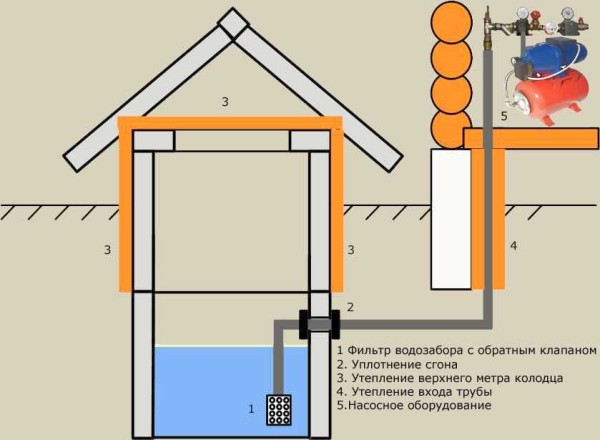
Organization of a water supply system in the country from a well with a hydraulic accumulator
When the tap opens (household appliances turn on or watering starts), water is supplied from the accumulator. The pressure in it gradually decreases. Its value is controlled by special relays. As soon as the lower threshold is reached, the pump turns on, restoring its set value. The upper threshold is controlled by a second sensor, which switches off the pump.
A similar the country water supply system can be implemented as in the winter, and in the summer version. The difference is where to install the equipment and how deep to bury the pipes.
What pipes to choose for water supply in the country
Even a decade and a half ago, no questions arose: there was no alternative to steel pipes. Today, metal is almost never used for the suburban water supply system: it is expensive, welding is needed for installation, and modern pipes rust quickly. There is a much more practical alternative - plastic pipes. They are the best solution for the country water supply system: they definitely do not rust, some are also not afraid of frost. But plastic is different, as are the products made from it.
HDPE pipes
Most often, HDPE pipes are used for water supply in the country. They are attractive in that they can be assembled without any additional devices. Fittings for assembling HDPE water pipes are threaded and simply twisted by hand.
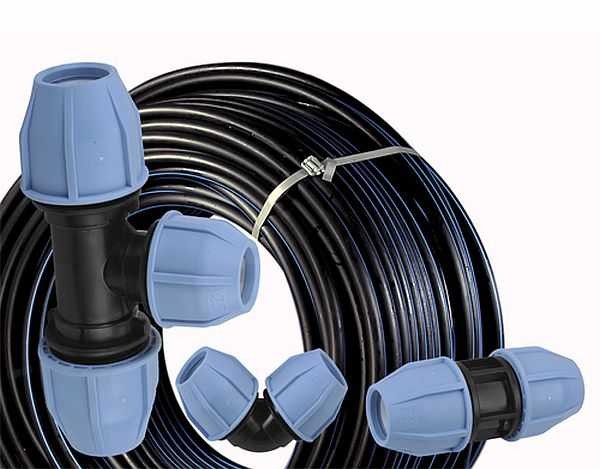
HDPE pipes for water supply systems are produced in coils or sections (depending on the diameter)
Why are HDPE polyethylene pipes so good that they almost replaced metal ones? In addition to convenient installation, there are a number of other advantages:
- Subject to the rules of operation, the service life is 50 years. This figure has not yet been verified, but it is impressive.
- They do not rot, rust, and are resistant to chemical environments.
- They can be used at temperatures down to -60 ° C.
- When the water freezes in them, they do not burst - they stretch, then after thawing they take the same size.
- Their inner surface is perfectly smooth. For a water supply system, this is important for two reasons: there is less pressure loss during transportation and deposits do not accumulate on the walls, they are simply carried away by the stream.
- With their help, it is very simple to make a water supply system in the country with your own hands, just like making changes later.
- You can use HDPE pipes for summer and winter water supply.
- Convenient assembly methods: by welding or on compression (threaded) fittings.
There are disadvantages, but there are few of them:
- they do not tolerate heat well (except for pipes made of cross-linked polyethylene), therefore they are used only for transporting cold media;
- when compared with metal, they have a lower strength - you cannot walk on them.
HDPE pipes can be welded with a special device, or they can be connected using compression fittings. For the suburban water supply, pipe pieces, tees, adapters are connected using threaded connections. Although such a connection seems unreliable, it can withstand much more than the 2-4 atm that you can create to the maximum. See the video for the test results of connections on threaded fittings. At the same time, see their design and installation principle.
HDPE pipes with blue lines are suitable for water supply. They are designed for cold water. If the lines are yellow - they cannot be used for water supply - they are intended for gas. They contain special additives that make the water unusable.
There are several gradations for working pressure:
- L - light, withstand up to 2.5 atm;
- SL - medium-light - up to 4 atm;
- C - medium - up to 8 atm;
- T - heavy from 10 and above.
For the installation of an external (street) water supply system in the country, HDPE pipes of class C and SL, with diameters of 32 mm, 40 mm and 50 mm, are used. When choosing, you still need to decide on the density.
There are three more grades of polyethylene: PE 63, 80, 100. These numbers mean density. The denser the material, the more durable the product, but also the higher the price. For example, one running meter of 32 mm PE 80 pipe costs from $ 4 (and more depending on the wall thickness). The same diameter, but made of PE 100 already from $ 7 per running meter.
Do you need a high density when installing a water supply system at chacha? Maybe yes. Due to the higher density, the pipe walls are made thinner, which reduces their weight. If water in the country comes from a well or well, weight can be an important factor - there will be less problems with securing the pipe down.
PVC pipes
For the water supply in the country, they also use PVC pipes - polyvinyl chloride. They are cheaper than HDPE, they are connected using cold welding - with glue. The seam turns out to be reliable - it tolerates pressure up to 12-16 atm, the service life is declared the same: 50 years.
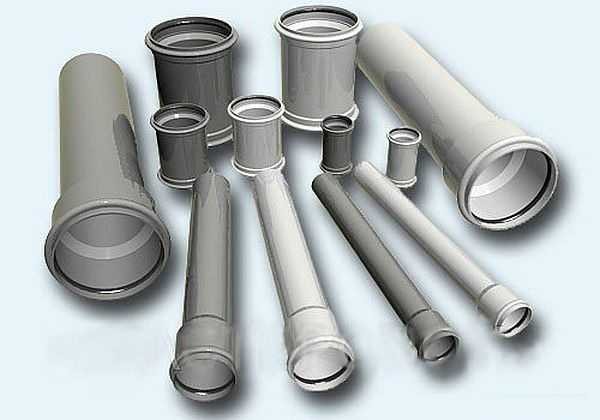
PVC pipes are inexpensive, but they cannot be scratched
Slightly worse performance than low pressure polyethylene:
- Temperature range of use from -15 ° C to + 45 ° C.
- Does not like freezing - elasticity decreases, the material becomes more brittle.
- Average sensitivity to ultraviolet radiation.
The rest of the advantages of plastic pipes are inherent in PVC in full:
- Ease of installation, the possibility of bending.
- Smoothness of the inner surface.
- Resistant to oxidation (does not rust) and chemical environments.
- Low-combustible.
The disadvantages of a suburban PVC plastic water pipe are as follows:
- Upper temperature limit + 45 ° C, short-term possible up to + 65 ° C.
- Difficult to dispose of as it emits volatile chlorides on decomposition, which are harmful to health and the environment.
- When scratches appear on the pipe surface, its strength is significantly reduced. Therefore, it is undesirable to use PVC pipes for open laying of a water supply system in the country. When laying underground, a protective shell or laying in a sewer is mandatory.
Since scratches and cracks greatly reduce the reliability, threaded connections are not possible. This is a big problem when docked with metal pipes or equipment entrances. And if piping around the site is not difficult, then piping equipment is a serious task. This drawback limits the use of this material for external water supply systems, because PVC is more often used for internal wiring, where the risks of scratching are minimal. They are also used more often for laying sewers.
How to connect PVC pipes, see the video. The connection is really reliable. This conclusion is based on personal experience: a comb of cold water was assembled in the apartment. It stood for about 10 years without any problems, until the entire wiring had to be redone due to redevelopment.
Polypropylene (PPR)
Another material that can be used when laying a water supply system in the country with your own hands is polypropylene pipes. They also belong to the category of plastics. There is for cold (with blue stripes) and hot water supply, as well as for heating (with red stripes). They are connected using soldering and couplings - there are special soldering irons, with the help of which the plastic is heated on two parts, then they are connected. After a couple of minutes, the connection becomes monolithic. It is not even necessary to buy a soldering iron (it costs about 2-5 thousand rubles) - it is rented in the same stores where pipes and fittings for polypropylene water supply are sold.
The disadvantage of polypropylene pipes is essentially one - expensive fittings. For example, a running meter of a pipe for cold water supply 32 mm in diameter (wall thickness 3 mm) costs about $ 2, a coupling for connecting two segments of the same diameter is $ 1.2. Since the PPR pipe does not bend, everything is assembled using couplings, corners, etc. As a result, the water supply is not very cheap, but reliable. After all, not only household water pipes are collected from this material, but also industrial routes.
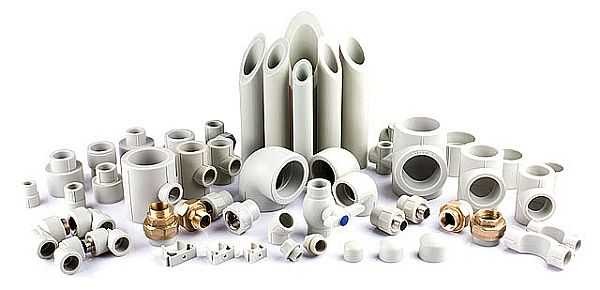
Polypropylene pipes for country water supply - a good, reliable option
You can read about drip irrigation systems and how to make them yourself in this article.
How to assemble a plumbing
When assembling a water supply system in the country with your own hands, you need to decide in which parts of the site you need wiring. It goes without saying that water must be supplied to the house. But in addition to the distribution of the water supply around the house, it is necessary for watering to lead pipes to key places on the site, put taps on them. If necessary, connect a hose to them and, by shifting it from place to place or by installing a sprinkler, water the nearby beds.
How to bring water into the house, read here, and how should be done the wiring of the water supply system at the summer cottage with our own hands, let's talk further. The best way to draw the plan is to scale. If you already have beds, you can easily determine where you need to deliver water. It is better to do several points of water intake: long hoses are inconvenient and difficult to carry, and having the opportunity to connect several at the same time, you will cope with watering faster.
When drawing up a diagram, do not forget about the need to install cranes on the highway: cut after the branch is still in the house, and then, on the site, before the first branch. It is desirable to install cranes further on the highway: this way it will be possible to turn off the emergency section in case of problems.
Even if a summer water supply system is equipped, you will need to drain the water from the pipes so that when it freezes, it does not break them. To do this, you need a drain valve at the lowest point. Then it will be possible to close the tap in the house, and drain all the water, protecting the water supply from damage in the winter. This is not necessary if the pipes for the country water supply are mounted from polyethylene pipes (HDPE).
After drawing the diagram, consider the footage of pipes, draw and consider what fittings are needed - tees, corners, taps, couplings, adapters, etc.
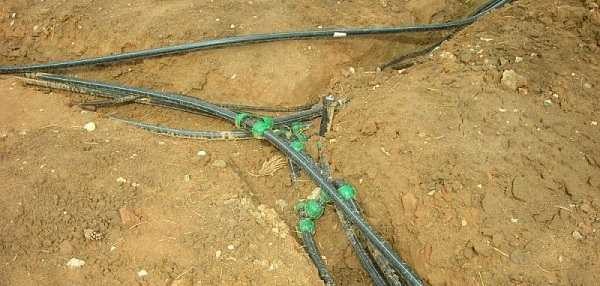
In order to correctly calculate the material and make the correct wiring of the water supply system in the country with your own hands, first draw a plan where you can calculate the footage and the number of fittings
Then you need to decide on the mode of use. There are two options: summer and winter water supply. They differ in the depth to which the pipes are buried. If your dacha is all-season, then you will have to lay an insulated water supply system in the dacha itself or bury it below the freezing depth. For the distribution of irrigation pipes in the country, it is more rational to use the summer version of the water supply system. You will only need a winter one if you have a greenhouse equipped. Then the section of the water supply system to the greenhouse will need to be equipped seriously: dig a good ditch and lay insulated pipes.
Summer water supply in the country
Depending on which pipes you will use, they can be left at the top, or they can be laid in shallow ditches. Installation of a suburban water supply system underground will take longer, but it is more reliable.
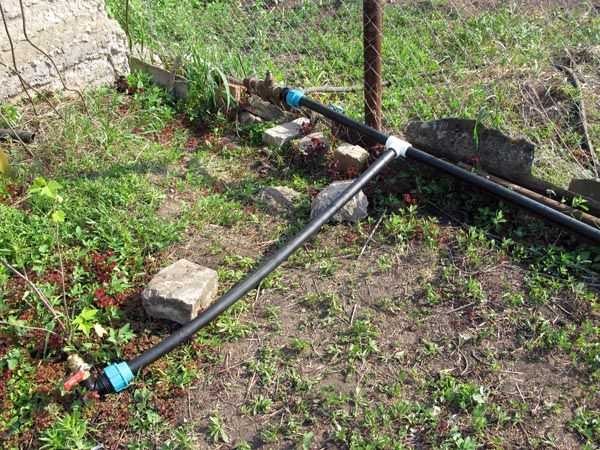
The surface wiring of the water supply system for irrigation in the country with their own hands is done quickly, but the pipes lying on the surface can be damaged
Having decided whether you need trenches or not, and having dug them out, if you have chosen an underground option, the pipes are stretched and laid out over the site. In this way, the correctness of the calculations is checked again. Then you assemble the system. The final stage - testing - turn on the pump and check the quality of the joints.
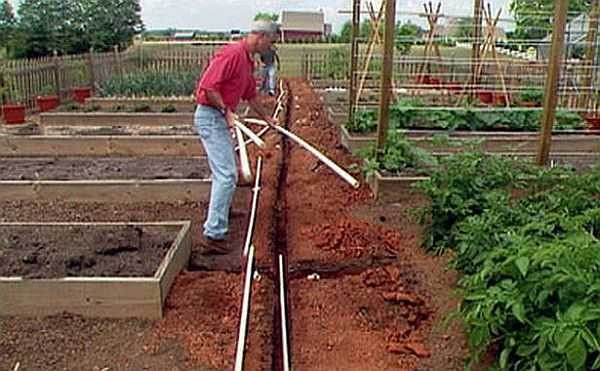
Before starting the installation of the water supply system at the summer cottage, the pipes are laid out in the right places
The winter water supply system differs from the flight one in that the areas that will be operated in the cold season must be guaranteed to be protected from freezing. They can be laid in trenches below the freezing depth, and / or insulated and / or heated with heating cables.
You can read about the organization of autowatering here.
Autonomous water supply in the country
Since the lights are often turned off in rural areas, and any pump can only work if electricity is available, it would be nice to have a reserve supply of water in case of a shutdown. This can be a container installed in the attic or on a separate site. Water can be pumped into it with a submersible pump from a well, a well, a river. And the pumping station will "draw" water from this tank.
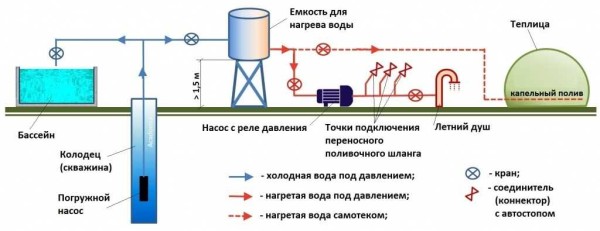
Autonomous water supply system from the tank. An approximate diagram with a reserve supply of water in the tank
The water supply system in the country from the tank is convenient in that rainwater can also be collected in it, but at the same time good filter system: first rough cleaning, then a few pieces of fine. And be sure to put a filter and a check valve at the inlet of the suction pipeline from the pumping station. The filter is for insurance - the equipment is demanding on the quality of the water, and the valve, so that when the pump is turned off, the water is not dumped back.
The presence of a tank in the water supply system of the summer cottage is also good for plants: in the summer, if it is installed outside, the water will heat up. And it is known that plants watered with warm water grow more actively and bear fruit better.
If desired, you can organize drip irrigation - assemble a line from the pipes, insert tees in the right places, to which you can connect hoses for drip irrigation.
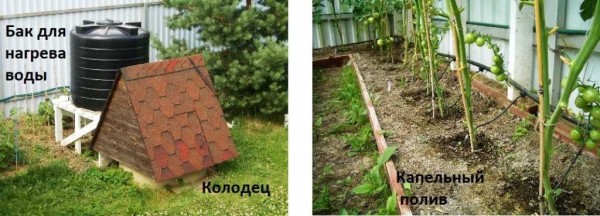
The drip irrigation system can be organized even when you make a water supply in the country with your own hands
This is how it looks schematically. Raise the tank to a height of at least 1 meter. You pump water into it from a well, a well, a river. Its level is controlled by a float mechanism (such as those in the flush cisterns). From the bottom of the tank there is a layout in the beds. First, there is a one-piece water pipe, and a drip pipe leaves the tee - with holes.
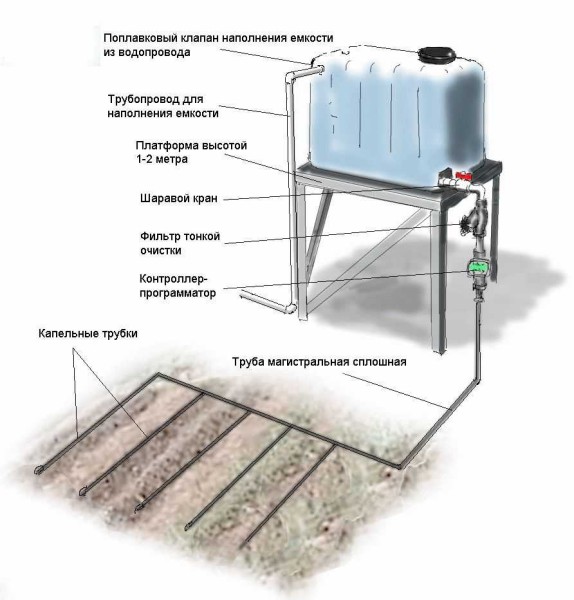
How to make a water supply in the country for watering from a barrel

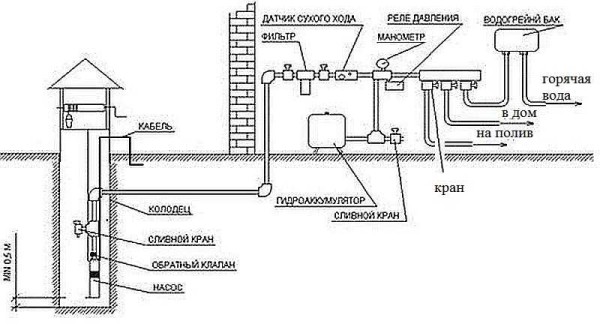
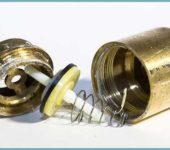
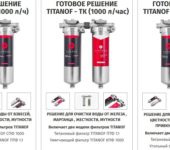

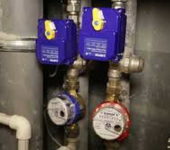
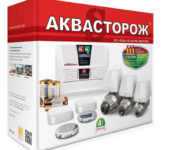





HDPE pipes really survived the frost. I could not come to drain the water and turn on the taps at the dacha last fall from the water supply above the ground. In the spring I was surprised. Everything remained intact.
About five years ago, specific frosts hit our area, but the ground was not covered with snow. Many people have frozen water in the pipes running from the street route to the houses. Communal workers came and warmed them up by inserting a capillary tube with a tip into the pipe, into which hot water was pumped using a garden sprayer of the "Zhuk" type. So, the benefit is now used for underground water pipelines HDPE polyethylene pipes - no one burst. In general, my track froze several times, and once it was frozen for more than a week. He warmed him up without any visible consequences.
I want to share my experience in the country water supply. Water is supplied from the well by a submersible pump through a ”PVC garden hose. The hose without insulation and without a heating cable lies on the surface of the earth, partly underground at a shallow depth. I have been using this system for over 10 years. And the water in the hose never froze. Because:
one). I poked a hole in the hose next to the pump with a 2 mm awl. When the pump is turned off, water from the hose slowly flows back into the well through the hole and does not freeze even in severe frost.
(Water also flows out through the hole when the pump is running, but this has practically no effect on the overall performance).
Now, instead of a vibration pump, I have a centrifugal borehole pump. I screwed the outlet connection to it without a sealing gasket. The result is the same.
2). The entire length of the hose has a greater or lesser slope towards the well. Water should not linger in it.
3.) Another prerequisite:
The water inlet into the storage tank must be higher than the water level in it, otherwise, when the pump is not working, water will flow back into the well not only from the hose, but also from the storage tank.
As they say, ingenious is simple. At one time he lived in a village where almost no one had water in their houses. Each in the yard has a well of about 2.5 meters into which water is brought from the highway, then water is fed upward through a steel gander. In the lower part of the gander, the same hole was drilled by 2-3 mm so that in winter the water flows into the well.
Thank you very helpful!